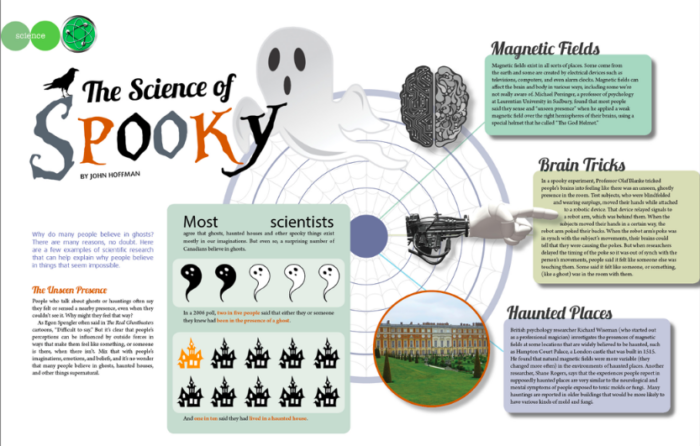

The Science of Spooky
Why do many people believe in ghosts? There are many reasons, no doubt. Here are a few examples of scientific research that can help explain why people believe in things that seem impossible.
The Unseen Presence
People who talk about ghosts or hauntings often say they felt or sensed a nearby presence, even when they couldn’t see it. Why might they feel that way? As Egon Spengler often said in The Real Ghostbusters cartoons, “Difficult to say.” But it’s clear that people’s perceptions can be influenced by outside forces in ways that make them feel like something or someone is there, when there isn’t. Mix that with people’s imaginations, emotions, and beliefs, it’s no wonder that many people believe in ghosts, haunted houses, and other things supernatural.
Most scientists agree that ghosts, haunted houses, and other spooky things exist mostly in our imaginations. But even so, a surprising number of Canadians believe in ghosts. In a 2006 poll, two in five people said that either they or someone they knew had been in the presence of a ghost. And one in ten said they had lived in a haunted house.
Magnetic Fields
Magnetic fields exist in all sorts of places. Some come from earth and some are created by electrical devices such as televisions, computers, and even alarm clocks. Magnetic fields can affect the brain and body in various ways, including some we’re not really aware of. Michael Persinger, a professor of psychology at Laurentian University in Sudbury, found that most people said they sense an “unseen presence” when he applied a weak magnetic field over the right hemispheres of their brains, using a special helmet that he called “The God Helmet”.
Brain Tricks
In a spooky experiment, Professor Olaf Blanke tricked people’s brains into feeling like there was an unseen, ghostly presence in the room. Test subjects, who were blindfolded and wearing earplugs, moved their hands while attached to a robotic device. That device relayed signals to a robot arm, which was behind them. When the subjects moved their hands in a certain way, the robot arm poked their backs. When the robot arm’s poke was in synch with the subjects’s movements, their brains could tell that they were causing the pokes. But when researches delayed the timing of the poke so it was out of synch with the person’s movements, people said it felt like someone else was poking them. Someone said it felt like someone or something (like a ghost) was in the room with them.
Haunted Places
British psychology researcher Richard Wiserman (who started out as a professional magician) investigates the presences of magnetic fields at some locations that are widely believed to be haunted, such as Hampton Court Place, a London castle that was built in 1515. He found that natural magnetic fields were more variable (they changed more often) in the environments of haunted places. Another researcher, Shane Rogers, says that the experiences people reported in supposedly haunted places are very similar to the neurological and mental symptoms of people exposed to toxic molds of fungi. Many hauntings are reported in older buildings that would be more likely to have various kinds of molds and fungi.
